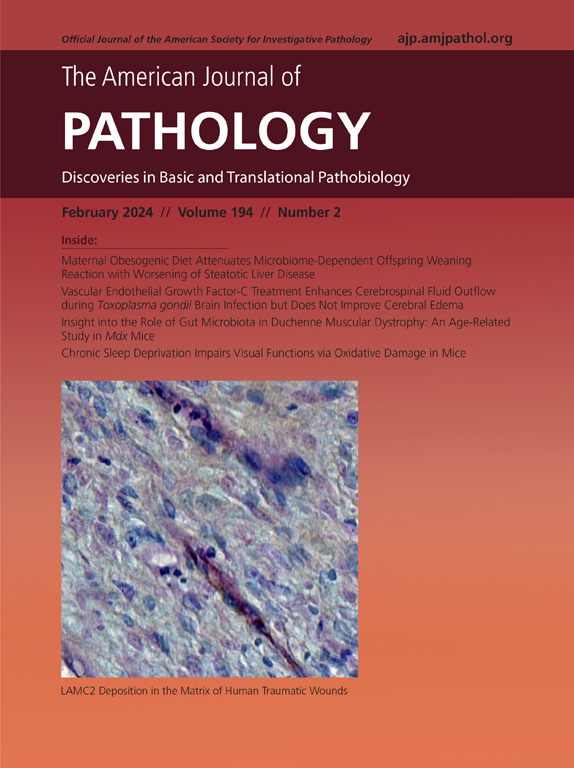线粒体功能障碍在子宫腺肌症发育过程中的参与。
IF 3.6
2区 医学
Q1 PATHOLOGY
引用次数: 0
摘要
子宫腺肌症的病因尚不清楚。上皮-间质转化(epithelial-mesenchymal transition, EMT)和线粒体功能障碍之间的关联被认为与纤维化疾病有关。子宫腺肌症定义为肌层存在子宫内膜腺体和间质,伴有EMT和最终纤维化。因此,我们的目的是研究线粒体功能障碍在纤维化b子宫腺肌症中的作用。在小鼠和人腺肌体组织中检测线粒体完整性。对照组和他莫昔芬组小鼠分别于出生后第21天(PND)给予3-硝基丙酸(3-NPA,线粒体功能障碍诱导剂)和ng -硝基- l -精氨酸甲酯(L-NAME,线粒体功能障碍抑制剂)治疗,然后评估子宫腺肌症、EMT和纤维化以及线粒体自噬、氧化应激、转化生长因子β -1 (TGF-β1)的表达。在PND42检测子宫腺肌病的基因谱。腺肌体小鼠表现出EMT和纤维化的增加。腺肌体组织表现出一致的线粒体破坏,裂变、线粒体自噬体和溶酶体增加。线粒体自噬、氧化应激、TGF-β1水平持续升高。3-NPA诱导对照组小鼠线粒体功能障碍、线粒体自噬和纤维化的发生以及TGF-β1的表达。相反,L-NAME可减轻子宫腺肌病患者的线粒体功能障碍、线粒体自噬、纤维化和TGF-β1。基因谱分析显示,子宫腺肌病患者线粒体功能障碍相关基因的表达增加。我们发现线粒体功能障碍诱导的TGF-β1失调和纤维化与子宫腺肌症的发生有关。本文章由计算机程序翻译,如有差异,请以英文原文为准。

The Involvement of Mitochondrial Dysfunction during the Development of Adenomyosis
The etiology of adenomyosis remains unclear. The association between epithelial-mesenchymal transition (EMT) and mitochondrial dysfunction is involved in fibrotic diseases. Adenomyosis is defined as the existence of endometrial glands and stroma in the myometrium with EMT and ultimate fibrosis. This study was designed to investigate the involvement of mitochondrial dysfunction in fibrotic adenomyosis. Mitochondrial integrity was examined in mouse and human adenomyotic tissues. Control and tamoxifen-treated mice were treated with 3-nitropropionic acid (a mitochondrial dysfunction inducer) and NG-nitro-L-arginine methyl ester (a mitochondrial dysfunction inhibitor), respectively, at postnatal day 21, followed by an evaluation of adenomyosis, EMT, and fibrosis as well as the expression of mitophagy, oxidative stress, and transforming growth factor-β1 (TGF-β1). The gene profiles of adenomyotic uteri were examined at postnatal day 42. Adenomyotic mice exhibited increased development of EMT and fibrosis. Adenomyotic tissues showed consistent mitochondrial destruction with increased fission, mitophagosomes, and lysosomes. Besides, mitophagy, oxidative stress, and TGF-β1 levels were consistently increased. The mitochondrial dysfunction, the development of mitophagy and fibrosis, and TGF-β1 expression were induced by 3-nitropropionic acid in control uteri. In contrast, NG-nitro-L-arginine methyl ester attenuated mitochondrial dysfunction, mitophagy, fibrosis, and TGF-β1 in adenomyotic uteri. Gene profiling demonstrated increased expression of mitochondrial dysfunction–related genes in adenomyotic uteri. This indicates that mitochondrial dysfunction–induced TGF-β1 dysregulation and fibrosis are associated with the development of adenomyosis.
求助全文
通过发布文献求助,成功后即可免费获取论文全文。
去求助
来源期刊
CiteScore
11.40
自引率
0.00%
发文量
178
审稿时长
30 days
期刊介绍:
The American Journal of Pathology, official journal of the American Society for Investigative Pathology, published by Elsevier, Inc., seeks high-quality original research reports, reviews, and commentaries related to the molecular and cellular basis of disease. The editors will consider basic, translational, and clinical investigations that directly address mechanisms of pathogenesis or provide a foundation for future mechanistic inquiries. Examples of such foundational investigations include data mining, identification of biomarkers, molecular pathology, and discovery research. Foundational studies that incorporate deep learning and artificial intelligence are also welcome. High priority is given to studies of human disease and relevant experimental models using molecular, cellular, and organismal approaches.

 求助内容:
求助内容: 应助结果提醒方式:
应助结果提醒方式:


